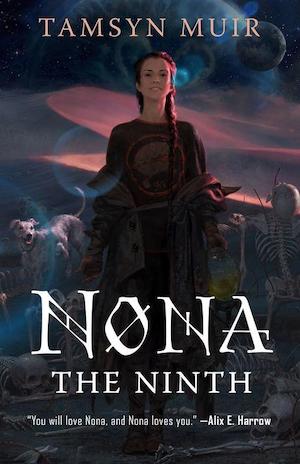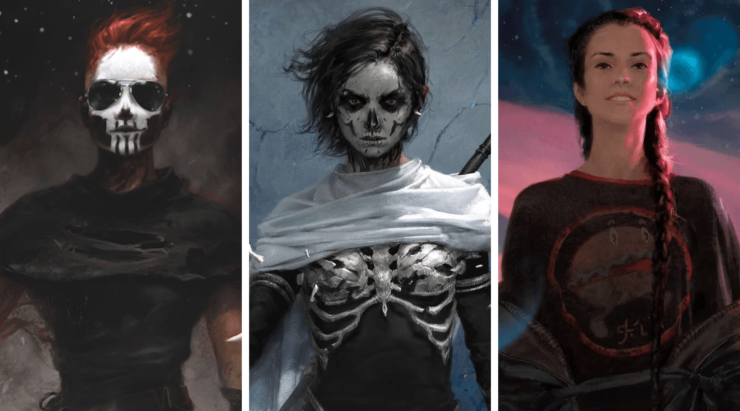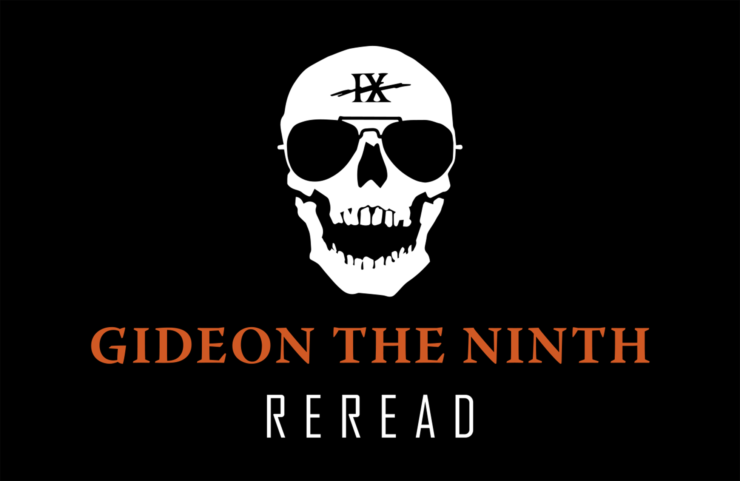Tamsyn Muir’s Locked Tomb series is the most unequivocally sapphic science-fiction series I’ve ever had the pleasure of reading. It is also a series in which—thus far in the books’ publication—the primary lesbian love interests have yet to even kiss.
The Locked Tomb is currently comprised of Gideon the Ninth and its sequel Harrow the Ninth, with Nona the Ninth publishing on September 13, 2022, and another unpublished installment set for release in the fall of 2023. The story follows the adventures of Gideon Nav and Harrowhark Nonagesiums. Gideon and Harrow both belong to the Ninth House, a cult of necromantic priests tasked with guarding the tomb where the greatest enemy of God lays buried. Harrow is the Ninth House’s heir while Gideon is an indentured servant, and the two women hate each other with a passion. Gideon the Ninth begins when Harrow is invited to attempt a series of trials required to become one of God’s Lyctors. These trials require a cavalier—a non-necromantic bodyguard—to participate. As the only competent sword-wielder available from the Ninth House, Gideon finds herself forced to act as Harrow’s cavalier.
The Locked Tomb is, in the author’s own words, “quite chaste.” Sex, on the rare occasions it makes an appearance, is often more comedic than dramatic. The books offer their readers a wealth of dirty jokes; a protagonist with a taste for pornographic magazines; and even a threesome between God and two of his saints. Yet, any sincere expressions of romance or desire are left to bubble as tensions in the background for the most part. While this approach to sapphic sci-fi is sure to disappoint some readers looking for more overtly romantic plotlines, I personally can’t get enough of it. Rather than relying on romance to construct the sexuality of her characters, Muir employs a kind of stylistic characterization which I can only describe as “dyke camp.”
Camp has always been associated with a love of archetype. As Susan Sontag wrote in her 1961 treatise on the subject, “Camp is the glorification of ‘Character'[….] What the Camp eye appreciates is the unity, the force of a person.” Muir’s characters, each audacious amalgamations of SFF aesthetics and fanfiction tropes, are nothing if not forceful. However, as books about lesbians, Gideon the Ninth and Harrow the Ninth have a uniquely lesbian take on archetype. “If camp is the love of the unnatural,” writes Mikaella Clements, “dyke camp is the love of the ultra-natural[….] Rather than drag, which parodies what is real, dyke camp takes the real and magnifies it, so that it becomes absurd or funny or simply attractive in its own right.”
This love of the ultra-natural is especially apparent in Muir’s blending of genre. Space Operas have always had a tendency to lean towards science-fantasy rather than science fiction. However, where other space operas often translate fantasy tropes into the aesthetics of science fiction, The Locked Tomb opts to recreate its swords & sorcery aesthetics wholesale. The cavaliers don’t fight with laser swords, but with steel. The necromancers don’t wear spacesuits, but billowy wizard’s robes. The permeation of these high fantasy aesthetics within The Locked Tomb’s otherwise science fictional world creates a complex relationship between nature and artifice. The aesthetics of science fiction are the aesthetics of the unnatural—of faster-than-light space travel and artificial intelligence. In contrast, the aesthetics of high fantasy often naturalize even the man-made. Fantasy seeks to disguise the fact that a sword is just as much a piece of human technology as a computer is. Gideon’s longsword is always drawing attention to her naturalness—the fighter’s instincts and muscular biceps required to wield such a weapon. Clements writes that “dyke camp clothing is linked intrinsically to the body that’s underneath” and I think a similar argument can be made about high fantasy aesthetics. In The Locked Tomb, the fantastical elements of Harrow’s appearance—her necromancer’s robes and constantly painted face—are always drawing attention to her rare moments of nudity.
As you might expect from a story about necromancers, The Locked Tomb contains a lot of descriptions of bodies, both living and dead. Gideon the Ninth’s Canaan House has frequently been compared to Titus Groan’s Gormenghast, but the exaggerated personalities and proportions of Muir’s characters bear a further resemblance to the writing of Mervyn Peake. One character is described as looking like “a collection of lemons in a sack,” another as having “an air of hair gel and filigree.” These descriptions are not masks or deceptions. As the story unfolds, these observations only prove to be increasingly insightful. Yet, the narrative’s constant magnification of these personalities transforms the reader’s perspective on them—sometimes even when the characters themselves remain relatively static.
The Locked Tomb’s secondary antagonist, Ianthe Tridentarius, exemplifies this constant magnification of personality. In Gideon the Ninth, she is debuted as the “starved shadow of [her twin]” with hair the color of “canned butter.” This grotesque description is amplified by her abhorrent personality and desire for power as she murders her own cavalier and abandons her sister in order to become a Lyctor. Yet, Harrow admits to finding Ianthe “beautiful” in the prologue to Harrow the Ninth, and by the end of the book the readers can only agree with her.
Buy the Book


Nona the Ninth
Ianthe’s character is given far more attention in Harrow the Ninth than in the previous novel, as she and Harrow take up occupancy on the Mithraeum. The two women begin to develop homoerotic tensions as they train together as Lyctors. Yet, while Ianthe’s personality is fleshed out by the second book, nothing about her appearance is substantially altered. Ianthe has not become “beautiful” by showing some aspect of her character that was previously hidden, or by redeeming herself morally (Muir has explicitly stated she has no interest in giving the character a redemption arc). This is character magnification, rather than character growth. Harrow and the reader have grown so uncomfortably intimate with Ianthe over the course of Harrow the Ninth that this intimacy itself renders her beautiful.
One scene in Harrow the Ninth has Harrow reconstructing Ianthe’s severed arm—an interaction which TamsynMuir describes as the novel’s lone “sex scene”:
You had understood what to do with her body innately[….] When you trailed your fingers up that new trunk of electrified humerus, [Ianthe] almost spat out the chunk of lace–– when you pressed your palm into her shoulder and plugged her in, she sobbed, rhythmically, beneath you.
One of the things that struck me while re-reading this passage is that the eroticism of this scene is mostly metonymic rather than metaphoric. Muir does not dress up the operation in the figurative language of sex, there is no attempt to euphemize the horror of the scene. On the contrary, the operation becomes erotic via the same means it becomes horrific. The adjacency of the operation’s circumstances to sex—Harrow’s intuitive knowledge of “what to do with” Ianthe’s body; the closeness of one girl to the other; the intense, uncomfortable intimacy of the procedure—are what construct the scene as sexual.
This approach to writing sexuality is the epitome of dyke camp. Physicality is exaggerated to such a degree that the reader cannot tell where the grotesque ends and the erotic begins, or if there is any distinction between the two at all. This ability to exist in a state of sexual ambiguity is a powerful poetic tool with which to depict queer women. As gender studies scholar Suzanne Iazenza notes, “lesbian women are often depicted either as the sexually aggressive woman of heterosexual male porno fantasies or as the asexual woman of the Jane Hathaway variety.”
How do you depict sex whilst resisting fetishization? While there is no one answer to this catch-22, Muir’s approach is an interesting and important one. She answers the paradox of lesbian representation with paradoxes of her own; with characters who are simultaneously grotesque and beautiful, alluring and repulsive, chaste and desirous.
***
Works Cited
- Iasenza, Suzanne. “Beyond ‘Lesbian Bed Death’: The Passion and Play in Lesbian Relationships.” Journal of Lesbian Studies, vol. 6, issue. 1, 2002.
- Muir, Tamsyn. Gideon the Ninth. Tor Books, 2019.
- Muir, Tamsyn. Harrow the Ninth. Tor Books, 2020.
- Sontag, Susan. “Notes on ‘Camp.” Against Interpretation and Other Essays, 1966. Reprinted by Penguin Books, 2018.
Kate Wallace Fry is a writer and academic from unceded Musqueam, Squamish, and Tsleil-Waututh territories (otherwise known as Vancouver, Canada). Kate currently lives in Scotland, where she is completing an MLitt in Fantasy Literature at the University of Glasgow. Her research focuses on queer and utopian themes in contemporary speculative fiction. You can find her on Twitter @katewfry.











